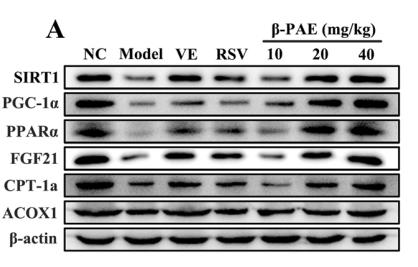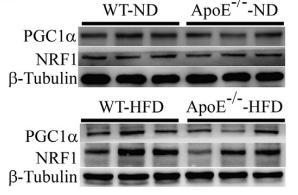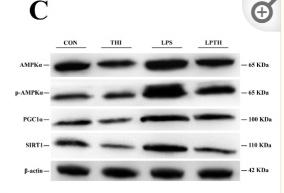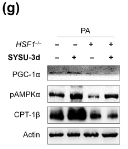| 产品: | PGC1 alpha 抗体 |
| 货号: | AF5395 |
| 描述: | Rabbit polyclonal antibody to PGC1 alpha |
| 应用: | WB IHC |
| 文献验证: | WB, IHC |
| 反应: | Human, Mouse, Rat |
| 预测: | Pig, Bovine, Horse, Rabbit, Dog, Chicken, Xenopus |
| 分子量: | 90~140 kD; 91kD(Calculated). |
| 蛋白号: | Q9UBK2 |
| RRID: | AB_2837880 |
产品描述
*The optimal dilutions should be determined by the end user.
*Tips:
WB: 适用于变性蛋白样本的免疫印迹检测. IHC: 适用于组织样本的石蜡(IHC-p)或冰冻(IHC-f)切片样本的免疫组化/荧光检测. IF/ICC: 适用于细胞样本的荧光检测. ELISA(peptide): 适用于抗原肽的ELISA检测.
引用格式: Affinity Biosciences Cat# AF5395, RRID:AB_2837880.
展开/折叠
L PGC 1alpha;LEM6;Ligand effect modulator 6;Peroxisome proliferative activated receptor gamma coactivator 1 alpha;Peroxisome proliferative activated receptor gamma coactivator 1;Peroxisome proliferator activated receptor gamma coactivator 1 alpha;Peroxisome proliferator activated receptor gamma coactivator 1 alpha transcript variant B4 3ext;Peroxisome proliferator activated receptor gamma coactivator 1 alpha transcript variant B4 8a;Peroxisome proliferator activated receptor gamma coactivator 1 alpha transcript variant B4;Peroxisome proliferator activated receptor gamma coactivator 1 alpha transcript variant B5;Peroxisome proliferator activated receptor gamma coactivator 1 alpha transcript variant B5 NT;Peroxisome proliferator-activated receptor gamma coactivator 1-alpha;PGC 1 (alpha);PGC 1 alpha;PGC 1v;PGC-1-alpha;PGC1;PGC1(alpha);PGC1A;PGC1v;PPAR gamma coactivator 1 alpha 3 ligand effect modulator 6;PPAR gamma coactivator 1 alpha;PPAR gamma coactivator 1;PPAR gamma coactivator variant form;PPAR-gamma coactivator 1-alpha;PPARGC 1 alpha;PPARGC-1-alpha;PPARGC1;PPARGC1A;PRGC1_HUMAN;
抗原和靶标
Heart, skeletal muscle, liver and kidney. Expressed at lower levels in brain and pancreas and at very low levels in the intestine and white adipose tissue. In skeletal muscle, levels were lower in obese than in lean subjects and fasting induced a 2-fold increase in levels in the skeletal muscle in obese subjects.
- Q9UBK2 PRGC1_HUMAN:
- Protein BLAST With
- NCBI/
- ExPASy/
- Uniprot
MAWDMCNQDSESVWSDIECAALVGEDQPLCPDLPELDLSELDVNDLDTDSFLGGLKWCSDQSEIISNQYNNEPSNIFEKIDEENEANLLAVLTETLDSLPVDEDGLPSFDALTDGDVTTDNEASPSSMPDGTPPPQEAEEPSLLKKLLLAPANTQLSYNECSGLSTQNHANHNHRIRTNPAIVKTENSWSNKAKSICQQQKPQRRPCSELLKYLTTNDDPPHTKPTENRNSSRDKCTSKKKSHTQSQSQHLQAKPTTLSLPLTPESPNDPKGSPFENKTIERTLSVELSGTAGLTPPTTPPHKANQDNPFRASPKLKSSCKTVVPPPSKKPRYSESSGTQGNNSTKKGPEQSELYAQLSKSSVLTGGHEERKTKRPSLRLFGDHDYCQSINSKTEILINISQELQDSRQLENKDVSSDWQGQICSSTDSDQCYLRETLEASKQVSPCSTRKQLQDQEIRAELNKHFGHPSQAVFDDEADKTGELRDSDFSNEQFSKLPMFINSGLAMDGLFDDSEDESDKLSYPWDGTQSYSLFNVSPSCSSFNSPCRDSVSPPKSLFSQRPQRMRSRSRSFSRHRSCSRSPYSRSRSRSPGSRSSSRSCYYYESSHYRHRTHRNSPLYVRSRSRSPYSRRPRYDSYEEYQHERLKREEYRREYEKRESERAKQRERQRQKAIEERRVIYVGKIRPDTTRTELRDRFEVFGEIEECTVNLRDDGDSYGFITYRYTCDAFAALENGYTLRRSNETDFELYFCGRKQFFKSNYADLDSNSDDFDPASTKSKYDSLDFDSLLKEAQRSLRR
种属预测
score>80的预测可信度较高,可尝试用于WB检测。*预测模型主要基于免疫原序列比对,结果仅作参考,不作为质保凭据。
High(score>80) Medium(80>score>50) Low(score<50) No confidence
研究背景
Transcriptional coactivator for steroid receptors and nuclear receptors. Greatly increases the transcriptional activity of PPARG and thyroid hormone receptor on the uncoupling protein promoter. Can regulate key mitochondrial genes that contribute to the program of adaptive thermogenesis. Plays an essential role in metabolic reprogramming in response to dietary availability through coordination of the expression of a wide array of genes involved in glucose and fatty acid metabolism. Induces the expression of PERM1 in the skeletal muscle in an ESRRA-dependent manner. Also involved in the integration of the circadian rhythms and energy metabolism. Required for oscillatory expression of clock genes, such as ARNTL/BMAL1 and NR1D1, through the coactivation of RORA and RORC, and metabolic genes, such as PDK4 and PEPCK.
Phosphorylation by AMPK in skeletal muscle increases activation of its own promoter. Phosphorylated by CLK2.
Heavily acetylated by GCN5 and biologically inactive under conditions of high nutrients. Deacetylated by SIRT1 in low nutrients/high NAD conditions.
Ubiquitinated. Ubiquitination by RNF34 induces proteasomal degradation.
Nucleus. Nucleus>PML body.
Nucleus.
Cytoplasm. Nucleus.
Nucleus. Nucleus>PML body.
Nucleus.
Heart, skeletal muscle, liver and kidney. Expressed at lower levels in brain and pancreas and at very low levels in the intestine and white adipose tissue. In skeletal muscle, levels were lower in obese than in lean subjects and fasting induced a 2-fold increase in levels in the skeletal muscle in obese subjects.
Homooligomer. Interacts with MYBBP1A; inhibits MYBBP1A transcriptional activation (By similarity). Interacts with PRDM16, LPIN1 and PML (By similarity). Interacts (via LXXLL motif) with RORA and RORC (via AF-2 motif); activates RORA and RORC transcriptional activation (By similarity). Interacts with LRPPRC. Interacts with RNF34 (via RING-type zinc finger).
研究领域
· Environmental Information Processing > Signal transduction > AMPK signaling pathway. (View pathway)
· Environmental Information Processing > Signal transduction > Apelin signaling pathway. (View pathway)
· Human Diseases > Endocrine and metabolic diseases > Insulin resistance.
· Human Diseases > Neurodegenerative diseases > Huntington's disease.
· Organismal Systems > Aging > Longevity regulating pathway. (View pathway)
· Organismal Systems > Endocrine system > Insulin signaling pathway. (View pathway)
· Organismal Systems > Endocrine system > Adipocytokine signaling pathway.
· Organismal Systems > Endocrine system > Glucagon signaling pathway.
文献引用
Application: WB Species: Rat Sample: livers
Application: WB Species: Mouse Sample: endothelial cells
Application: WB Species: piglets Sample:
Application: WB Species: Goat Sample: RECs
限制条款
产品的规格、报价、验证数据请以官网为准,官网链接:www.affbiotech.com | www.affbiotech.cn(简体中文)| www.affbiotech.jp(日本語)产品的数据信息为Affinity所有,未经授权不得收集Affinity官网数据或资料用于商业用途,对抄袭产品数据的行为我们将保留诉诸法律的权利。
产品相关数据会因产品批次、产品检测情况随时调整,如您已订购该产品,请以订购时随货说明书为准,否则请以官网内容为准,官网内容有改动时恕不另行通知。
Affinity保证所销售产品均经过严格质量检测。如您购买的商品在规定时间内出现问题需要售后时,请您在Affinity官方渠道提交售后申请。产品仅供科学研究使用。不用于诊断和治疗。
产品未经授权不得转售。
Affinity Biosciences将不会对在使用我们的产品时可能发生的专利侵权或其他侵权行为负责。Affinity Biosciences, Affinity Biosciences标志和所有其他商标所有权归Affinity Biosciences LTD.






























